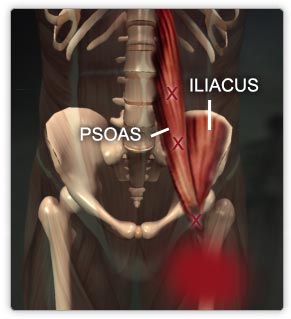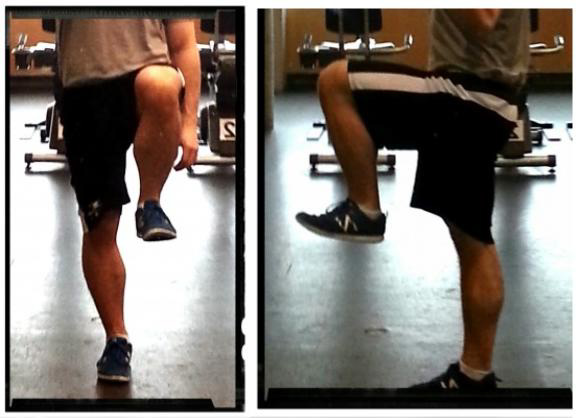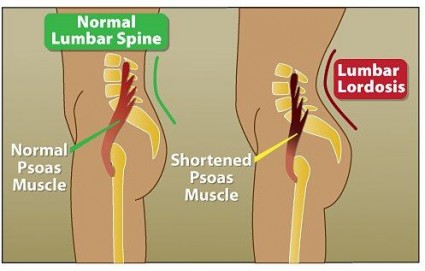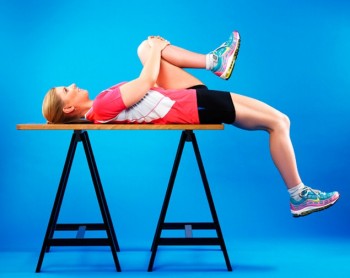The Psoas is one of those
“muscles of the minute”.
Just like the Glute Medius, Vastus Medialus and Rhomboids before it, right now EVERYTHING is somehow linked to a Psoas dysfunction issue.
This isn’t true….but it kinda is.
In the last 2 years I’ve had more and more clients than ever with Psoas issues.
But what is true is that the Psoas is waaaay more important than we used to think and in a lot of people, especially Desk Jockeys, it’s either not doing its job, it’s tight as hell or both.
Either way it can and probably is contributing to your back pain and/ or anterior hip pain.
Especially if you sit all day.
What and where the Psoas is:
It’s a muscle that connects the front of your leg at about the hip to your spine and attaches along several lower vertebra:

What it does:
The Psoas flexes the hip (knee to the chest) and arches the lower back.
It’s active in high knee raises (once the hip flexes past 90 degrees). Lift your leg when the crease at the top of your bent knee is parallel with the crease in your hip, the Psoas is doing that.

The Problem:
Sitting….Desk Jockey Syndrome.
We do too much of it and not a lot of activities that force the Psoas to activate like sprinting and kicking.
Because of that the Psoas tends to become short and weak.
When this happens the Psoas is incapable of helping to stabilize and control the movement of the Femur in the hip socket which leads to pain in the front of the hip at the top of the crease of the hip and/ or pain and stiffness in the lower back.

How to Fix it:
Stretch it!
The Psoas is incredibly difficult to do soft tissue work on for 99% of people so your best hope to restore normal length is through stretching. There are a million different variations of this stretch that do basically the same thing.
Try them and see which one gives you the best stretch.
Keep in mind to squeeze the glute of the foot that is on the bench to bring the pelvis into neutral positioning.
You can increase the stretch by reaching overhead, arching hard and leaning back.
The Thomas Stretch (below) is probably the best stretch but who the hell has a massage table sitting around….they say you can use a bed, and I guess you can use your kitchen table.

I’ve tried the bed thing and…it’s not so good….
But if you have the capabilities this is the BEST Psoas stretch.
It’s even better if you can get someone to gently push the leg of the foot that’s hanging off the table down.
The key to making this effective is to keep the hips from moving and a slight arch in the lower back the entire time.
Once you’ve restored normal length we want to keep it that way so it becomes necessary to strengthen the Psoas so it continues to do its job and doesn’t “go to sleep” and shut off again.
Strengthen it:
For the Psoas to activate the top of the knee MUST pass the crease in the top of the hip.
If this doesn’t happen then the Psoas doesn’t activate and noting is happening, your wasting your time.
By virtue of the band this can be the easiest exercise to begin with if you have trouble with knee flexion. Obviously you can make this exercise much harder by increasing band tension.
Key Points:
- Keep a slight arch in the lower back, just like you would normally have.
- Abs tight and hips LOCKED.
- Don’t let the hips roll back or shift while pulling.
- Place the hands under the lower back arch, the minute you feel pressure the hips have “rolled” back and the hip is no longer creating flexion. Stop the exercise.
Remember, the knee MUST pass the crease in the hip.
Once you’ve mastered this it’s time to move to a sitting position which will add an extra degree of difficulty because, unlike lying on the floor, gravity will load the hips.
Yes, this is the exercise your grandma did after breaking her hip. But you’re going to do it right.
Key Points:
- Sit tall with a slight arch in the lower back and stay tall.
- Seat should be at a height that creates a 90 degree angle at the hip and knee. A little lower or higher is fine, but shoot for 90.
- Keep the abs tight and hips LOCKED in place.
- Do not let the lower back move at all during the exercise.
- No leaning back or hiking the hips.
The next step in the process of Psoas domination activation is Hip Flexion while standing.
Again, NO LEANING or shifting of weight. Stay tall and locked in.
Key Points:
- Stand tall, lock the knee of the leg you’re standing on.
- Keep a slight arch in your lower back the whole time.
- No hiking or rotating the hip.
- Only flex the hip.
Remember, pain in the front part of the hip OR the back can be an indication of a Psoas issue and it WILL get worse if you don’t address it.
Even if you don’t have pain but you’re sitting a lot you should start stretching and strengthening your Psoas…it’s preventative maintenance folks.
Original article and pictures take www.roypumphrey.com site
Комментариев нет:
Отправить комментарий